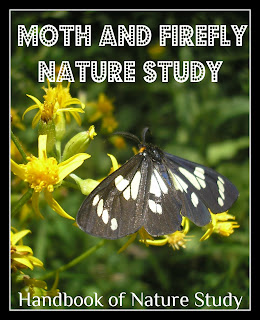
Outdoor Hour Challenge
Summer Series #8 Moths and Fireflies
Train Your Senses
- Sight: In the evenings, look for moths around outdoor lights. Look for the feathery antennae, the wings, and the eyes of the moth. Look for fireflies if they live in your area, noting their flight patterns and their light flashes.
- Touch: If you have the opportunity, carefully feel the wings of a moth.
1. Read in the Handbook of Nature Study pages 367 to 369 (Lesson 90) for fireflies and pages 310 to 329 (Lessons 72-76) for information about moths.

2. Read in Discover Nature at Sundown pages 93 to 114 for lots of wonderful information and suggestions for activities to study your local moths. Also, read pages 116 to 127 to learn more about fireflies and suggestions for their study.

Wild Forget Me Not moth- day flying moth
Outdoor Hour Time:
“After the outdoor observations have been made, collect some of these beetles in the evening with a sweep net; place them under a glass jar or tumbler, so that their light can be studied at close range.” Handbook of Nature Study, page 3681. If you live in an area that has fireflies, plan on taking your fifteen minutes of outdoor time this week in the evening hours.
Some suggestions for studying fireflies:
- Where do the fireflies gather? Field, meadow, stream, woods, over lawns?
- Are they up high near the treetops or low to the ground?
- Describe their flight pattern. Is it straight and fast, slow and curving?
- Is there a pattern to the light flashing? What color are the flashes?

Here is a website for further tips: How to Start Mothing.
You can collect a few moths in a jar and look at them with a hand lens before releasing them.
Follow-Up Activity:
The Handbook of Nature Study suggests making watercolor drawings of moths. If you have a real life specimen it will be a great way to encourage close observation. You can also use reference photos for moths you observed in your Outdoor Hour Time (do a quick Google image search). If you have a real-life specimen of a firefly, use the suggestions in the Handbook of Nature study to examine your firefly and then sketch it in your nature journal. You can use the notebook pages and coloring pages provided in the ebook for the moth and the firefly or your own blank journal.There are free Insect Study notebook pages in the Ant Study.

Post an entry on your blog sharing your experiences. You can link up by clicking the carnival button or you can send them directly to me: harmonyfinearts@yahoo.com.
If you would like all the Summer Series Challenges in one place, I have an ebook gathered for you to purchase for your convenience. Here is a link to a complete description:
Summer Series of Outdoor Hour Challenges
Post an entry on your blog sharing your experiences. You can link up by clicking the carnival button or you can send them directly to me: harmonyfinearts@yahoo.com.
If you would like all the Summer Series Challenges in one place, I have an ebook gathered for you to purchase for your convenience. Here is a link to a complete description:


Just when there was a subject we thought we knew a lot about...We learned so much about our lightening bugs!
ReplyDeletep.s. the children heard the nature sounds and knew it was your website up. They came running!
To find out what butterflies and/or moths are in your particuluar area in the USA try this link...it breaks it down to your county: http://www.butterfliesandmoths.org/map
ReplyDeleteIn the USA you can find out what butterflies and/or moths are in your area at: http://www.butterfliesandmoths.org/map (it breaks it down to county)
ReplyDeleteStill trying to catch up on our summer posts! Thanks for the challenges!
ReplyDelete